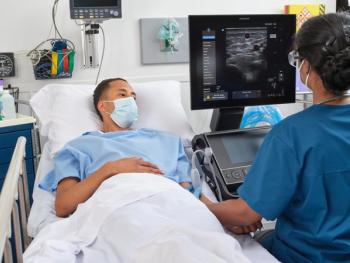
Lung ultrasound quickly spots acute respiratory failure
Specific lung ultrasound signs reliably indicate common causes of acute respiratory failure and rapidly differentiate it from similar diseases. More than 90% of patients admitted to university teaching hospital intensive care units with trouble breathing could have been easily diagnosed with lung ultrasound.
Specific lung ultrasound signs reliably indicate common causes of acute respiratory failure and rapidly differentiate it from similar diseases. More than 90% of patients admitted to university teaching hospital intensive care units with trouble breathing could have been easily diagnosed with lung ultrasound.
Drs. Daniel A. Lichtenstein and Gilbert A. Mezière at the Ambroise-Paré hospital in Paris studied 260 consecutive patients with respiratory failure admitted to the ICU of several teaching hospitals. Patients received lung ultrasound exams on presentation, and these results were compared with final diagnosis by the ICU team.
Exams included a venous analysis and looked for lung sliding, alveolar consolidation, pleural effusion, and artifacts, including horizontal A lines or vertical B lines indicating interstitial syndrome. These signs were grouped and compared with final clinical diagnoses to form unique disease profiles.
The researchers published their study in Chest, which made it available online April 10.
They found that a profile of A lines plus lung sliding matched up with 34 patients with asthma and 49 patients with chronic obstructive pulmonary disease with a sensitivity of 89% and specificity of 97%. A profile of multiple anterior diffuse B lines with lung sliding matched up with the 64 patients suffering pulmonary edema with a sensitivity of 97% and a specificity of 95%. A profile showing a normal anterior along with deep vein thrombosis matched up with 21 patients with pulmonary embolism with a sensitivity of 81% and specificity of 99%.
A profile of anterior absent lung sliding, A lines, and lung point matched up with nine patients with pneumothorax with a sensitivity of 81% and specificity of 100%. A profile showing anterior alveolar consolidations, anterior diffuse B lines with abolished lung sliding, anterior asymmetric interstitial patterns, posterior consolidations or effusions without anterior diffuse B lines matched up with the 83 pneumonia patients with a sensitivity of 89% and a specificity of 94%.
The researchers concluded that if these profiles had been used for early diagnosis in the ICU, they would have been correct 90.5% of the time and saved valuable time.
Newsletter
Stay at the forefront of radiology with the Diagnostic Imaging newsletter, delivering the latest news, clinical insights, and imaging advancements for today’s radiologists.




